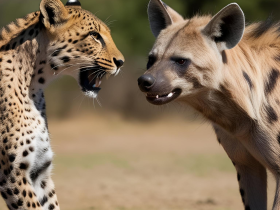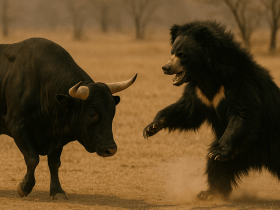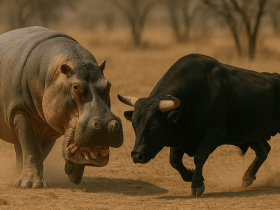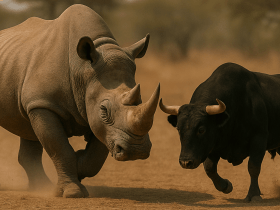Below is a full detailed article about Crocodile vs Hippopotamus.
Crocodile (scientific name: Crocodylus niloticus for the Nile crocodile)
Hippopotamus (scientific name: Hippopotamus amphibius)
Below tables cover 10 main topics by including all the numerical and scientifical data by comparing Crocodile vs Hippopotamus. Also I have included a winner column for further understanding, Hope you will enjoy!
1. Body Specifications
| Subtopics | Crocodile | Hippopotamus | Winner |
|---|---|---|---|
| Height | 50-60 cm at the shoulder (when standing) | 1.5-1.65 meters at the shoulder | Hippopotamus |
| Length | 4-5 meters (body), 1-1.5 meters (tail) | 3.3-5 meters (body), 35-50 cm (tail) | Tie |
| Weight | 225-750 kg | 1,300-1,800 kg (male), 1,300-1,500 kg (female) | Hippopotamus |
| Body Shape | Streamlined, armored, adapted for swimming and ambush | Barrel-shaped, adapted for semi-aquatic life | Tie |
| Bone Density | High, adapted for strength and swimming | High, adapted for supporting massive weight | Tie |
| Muscle Mass | 60-70% of body weight | 50-60% of body weight | Crocodile |
| Skull Size | 60-70 cm in length | 60-70 cm in length | Tie |
| Limb Strength | Powerful limbs for swimming and short bursts on land | Strong limbs for walking and swimming | Tie |
| Tail Function | Used for propulsion in water | Short tail, used for communication | Crocodile |
| Overall Build | Streamlined and armored, optimized for aquatic ambush | Massive and barrel-shaped, optimized for semi-aquatic life | Tie |
2. Skin and Coloration – Crocodile vs Hippopotamus
| Subtopics | Crocodile | Hippopotamus | Winner |
|---|---|---|---|
| Color | Dark green or brown with armored scales | Grayish-brown with pink undertones | Tie |
| Pattern | No distinct patterns | No distinct patterns | Tie |
| Function | Camouflage in water and protection | Camouflage in water and protection | Tie |
| Skin Thickness | 4-6 cm, armored with osteoderms | 5-6 cm, thick and tough | Tie |
| Sweat Glands | No sweat glands | Secretes “blood sweat” (red pigment) for sun protection | Hippopotamus |
| UV Protection | Relies on water for UV protection | Secretes natural sunscreen | Hippopotamus |
| Thermoregulation | Relies on water for thermoregulation | Relies on water for thermoregulation | Tie |
| Unique Features | Armored scales and osteoderms | Thick, hairless skin with pink secretions | Tie |
| Sensitivity | Sensitive to touch and vibrations | Sensitive to touch and vibrations | Tie |
| Overall Protection | Highly armored and protected | Thick skin and natural sunscreen | Tie |
3. Habitat and Range
| Subtopics | Crocodile | Hippopotamus | Winner |
|---|---|---|---|
| Geographic Range | Sub-Saharan Africa, Nile River | Sub-Saharan Africa | Tie |
| Habitat Type | Rivers, lakes, swamps, and estuaries | Rivers, lakes, and swamps | Tie |
| Adaptability | Highly adaptable to freshwater and brackish environments | Highly adaptable to freshwater environments | Tie |
| Climate Preference | Warm, tropical climates | Warm, tropical climates | Tie |
| Elevation Range | Sea level to 1,000 meters | Sea level to 2,000 meters | Hippopotamus |
| Territorial Range | 1-10 km² | 1-5 km² | Tie |
| Human Proximity | Can live near human settlements | Can live near human settlements | Tie |
| Migration Patterns | Non-migratory | Non-migratory | Tie |
| Population Density | Moderate density in suitable habitats | High density in suitable habitats | Hippopotamus |
| Endemism | Found in Africa and parts of Asia | Found in Africa | Crocodile |
4. Diet and Foraging – Crocodile vs Hippopotamus
| Subtopics | Crocodile | Hippopotamus | Winner |
|---|---|---|---|
| Diet Type | Carnivorous (fish, mammals, birds) | Herbivorous (grasses, aquatic plants) | Tie |
| Foraging Success Rate | High, due to ambush hunting | High, due to grazing efficiency | Tie |
| Daily Caloric Intake | 1,000-2,000 calories | 40-60 kg of vegetation daily | Hippopotamus |
| Foraging Techniques | Ambush hunting and scavenging | Grazing on land and aquatic plants | Tie |
| Prey Size | Up to 10 times their body weight | N/A (herbivorous) | Crocodile |
| Scavenging | Frequently scavenges | Rarely scavenges | Crocodile |
| Foraging Time | Nocturnal and crepuscular | Nocturnal grazing | Tie |
| Water Dependency | High, requires water for hunting and thermoregulation | High, requires water for thermoregulation | Tie |
| Food Storage | No food storage | No food storage | Tie |
| Competition | Competes with lions, hyenas, and other predators | Competes with other herbivores | Tie |
5. Strength and Bite Force
| Subtopics | Crocodile | Hippopotamus | Winner |
|---|---|---|---|
| Bite Force (PSI) | 3,700 PSI | 1,800 PSI | Crocodile |
| Claw Strength | No claws, but powerful jaws | No claws, but powerful jaws | Tie |
| Lifting Capacity | Can drag prey into water | Can lift 1-2 times its body weight | Tie |
| Jaw Structure | Long, powerful jaws for crushing | Wide, powerful jaws for grazing and defense | Tie |
| Neck Strength | Strong, adapted for gripping and twisting prey | Strong, adapted for supporting massive head | Tie |
| Forelimb Strength | Strong for swimming and short bursts on land | Strong for walking and swimming | Tie |
| Hind Limb Strength | Powerful for swimming | Powerful for walking and swimming | Tie |
| Overall Strength | Extremely powerful, adapted for aquatic ambush | Extremely powerful, adapted for defense and grazing | Tie |
| Combat Skills | Ambush-based, relies on stealth and bite force | Strength-based, relies on size and aggression | Tie |
| Endurance | High endurance for short bursts | High endurance for long periods | Hippopotamus |
6. Speed and Agility – Crocodile vs Hippopotamus
| Subtopics | Crocodile | Hippopotamus | Winner |
|---|---|---|---|
| Top Speed | 32 km/h (on land), 20 km/h (in water) | 30 km/h (on land), 8 km/h (in water) | Tie |
| Acceleration | Faster acceleration in water | Slower acceleration due to larger body | Crocodile |
| Agility in Water | Highly agile in water | Moderate agility in water | Crocodile |
| Agility on Land | Limited agility on land | Moderate agility on land | Hippopotamus |
| Stamina | High stamina for short bursts | High stamina for long periods | Hippopotamus |
| Jumping Ability | Limited jumping ability | Limited jumping ability | Tie |
| Maneuverability | Highly maneuverable in water | Less maneuverable on land | Crocodile |
| Reflexes | Extremely fast reflexes | Moderate reflexes | Crocodile |
| Balance | Excellent balance in water | Good balance on land | Tie |
| Overall Agility | Superior agility in water | Moderate agility on land | Crocodile |
7. Senses – Crocodile vs Hippopotamus
| Subtopics | Crocodile | Hippopotamus | Winner |
|---|---|---|---|
| Vision Acuity | Excellent night vision, binocular vision | Good night vision, binocular vision | Crocodile |
| Hearing Range | Can hear frequencies up to 50 kHz | Can hear frequencies up to 40 kHz | Crocodile |
| Olfactory Capabilities | Highly developed sense of smell | Moderate sense of smell | Crocodile |
| Whisker Sensitivity | No whiskers | No whiskers | Tie |
| Depth Perception | Excellent depth perception in water | Good depth perception in water | Crocodile |
| Color Vision | Limited color vision | Limited color vision | Tie |
| Motion Detection | Highly sensitive to motion | Moderately sensitive to motion | Crocodile |
| Low Light Vision | Superior low light vision | Good low light vision | Crocodile |
| Sensory Adaptations | Adapted for nocturnal hunting | Adapted for nocturnal grazing | Tie |
| Overall Senses | Superior senses for hunting and ambush | Good senses for grazing and defense | Crocodile |
8. Reproduction and Lifespan
| Subtopics | Crocodile | Hippopotamus | Winner |
|---|---|---|---|
| Gestation Period | 80-90 days | 240 days | Hippopotamus |
| Litter Size | 20-60 eggs | 1 calf | Crocodile |
| Infant Mortality Rate | 50-70% | 30-40% | Hippopotamus |
| Sexual Maturity | 10-12 years | 6-8 years | Hippopotamus |
| Lifespan (Wild) | 70-100 years | 40-50 years | Crocodile |
| Lifespan (Captivity) | 70-100 years | 50-60 years | Crocodile |
| Mating System | Polygamous | Polygamous | Tie |
| Parental Care | Mother guards nest and hatchlings | Mother raises calf alone | Tie |
| Weaning Age | 6-12 months | 6-8 months | Tie |
| Reproductive Rate | 1 clutch every 2-3 years | 1 calf every 2-3 years | Tie |
9. Social Behavior – Crocodile vs Hippopotamus
| Subtopics | Crocodile | Hippopotamus | Winner |
|---|---|---|---|
| Social Structure | Solitary, except during mating or nesting | Lives in groups of 10-30 individuals | Hippopotamus |
| Territorial Range | 1-10 km² | 1-5 km² | Tie |
| Communication | Vocalizations, body language, and scent marking | Vocalizations, body language, and scent marking | Tie |
| Dominance Hierarchy | No strict hierarchy | Strict hierarchy within groups | Hippopotamus |
| Cooperation | Minimal cooperation | High cooperation in group defense | Hippopotamus |
| Aggression Levels | Highly aggressive when threatened | Highly aggressive when defending territory | Tie |
| Play Behavior | Hatchlings engage in play | Calves engage in play | Tie |
| Grooming | No grooming | Mutual grooming within groups | Hippopotamus |
| Territorial Marking | Scent marking and vocalizations | Scent marking and vocalizations | Tie |
| Overall Sociability | Solitary and independent | Highly social and cooperative | Hippopotamus |
10. Conservation Status
| Subtopics | Crocodile | Hippopotamus | Winner |
|---|---|---|---|
| IUCN Status | Least Concern | Vulnerable | Crocodile |
| Population Trends | Stable, but threatened in some regions | Declining due to habitat loss and poaching | Crocodile |
| Threats | Habitat loss, poaching, and human-wildlife conflict | Habitat loss, poaching, and human-wildlife conflict | Tie |
| Conservation Efforts | Protected areas, anti-poaching initiatives | Protected areas, anti-poaching initiatives | Tie |
| Legal Protection | Protected under CITES Appendix I | Protected under CITES Appendix II | Crocodile |
| Population Size | Estimated 250,000-500,000 | Estimated 115,000-130,000 | Crocodile |
| Genetic Diversity | Moderate genetic diversity | Moderate genetic diversity | Tie |
| Human Impact | High due to habitat loss and poaching | High due to habitat loss and poaching | Tie |
| Reintroduction Programs | Limited reintroduction efforts | Active reintroduction efforts in some regions | Hippopotamus |
| Overall Outlook | Stable but threatened in some regions | Declining and threatened | Crocodile |
Overall Winner
- Crocodile: Wins in categories like bite force, senses, and agility in water.
- Hippopotamus: Wins in categories like social behavior, endurance, and size.
- Final Verdict: The hippopotamus has the edge in a one-on-one encounter due to its massive size, strength, and aggression, but the crocodile dominates in aquatic ambush and bite force.
References
- National Geographic: https://www.nationalgeographic.com
- IUCN Red List: https://www.iucnredlist.org
- Smithsonian’s National Zoo: https://nationalzoo.si.edu
- Journal of Zoology: Comparative studies on reptiles and mammals
- African Wildlife Foundation: https://www.awf.org
- World Wildlife Fund: https://www.worldwildlife.org
- Scientific Reports: Bite force and strength studies
- Encyclopedia Britannica: https://www.britannica.com
- San Diego Zoo Wildlife Alliance: https://animals.sandiegozoo.org
- BBC Earth: https://www.bbc.com/earth
Read More – Hippo vs Lion : A Comprehensive Comparison






Leave a Reply